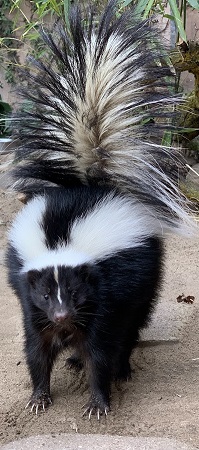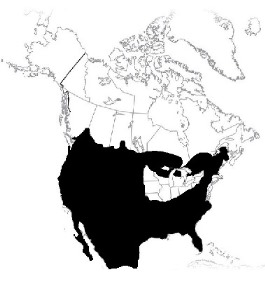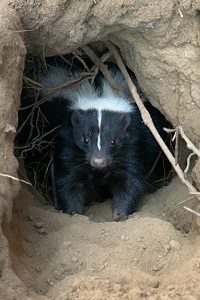Striped Skunk
Mephitis mephitis
- Habitat: Forests, coastal swamps, deserts and scrubland
- Range: Across North America (Canada, Mexico and the U.S.A)
- Natural Diet: Insects, small mammals, birds, eggs, fish, and crustaceans
- Status in the Wild: Common
All about the Striped Skunk
Striped skunks are carnivores and like wild dogs and wild cats, a portion of their diet is composed of meat. They are black and white in color and have two thick white stripes along the back and tail on an otherwise black coat, In contrast, their heads are black with a thin white strip running down along their snouts from their eyes to the tip of their snout. Their tails are black and white as well. The stripes give the animal its name. The colors help camouflage them from their predators. They are either active by night (nocturnal) or at dawn or dusk (crepuscular). Their biological rhythm helps them increase their hunting success by hunting when their prey is asleep.
Male Striped Skunks are slightly larger than females and are around 2.5 feet long. They can weigh between four to 10 pounds. Like other species of skunks, Striped Skunks have two well-developed scent glands in the anal region that they use to secrete an unpleasant musky odor to deter predators.
Diet/ Habitat/ Range
Striped Skunks are native to North America and range from Canada, across the United States, to northern Mexico. They live in diverse habitats across their distributional range which include forests, savanna-type habitats, shrublands, and grasslands.
They are insectivorous and predominantly feed on insects during late spring and the summer months. They also feed on small mammals, small birds, reptiles, amphibians, and other invertebrates. Although they primarily feed on animal matter, they have also been observed to feed on fruits, berries, nuts, and seeds.
Behavior
Striped Skunks are terrestrial and primarily live on the ground. Using their powerful claws they often dig underground dens in which they shelter during the day. They often use abandoned dens built by other animals. Striped Skunks also use their claws to dig the ground as they forage for grubs and ground-dwelling invertebrates.
Striped Skunks are usually non-aggressive but defend themselves arching their backs and flashing their tails to look bigger, stomping their feet, and by pretending to mock-charge when they are threatened.
Striped Skunks are not territorial nor are they aggressive toward other skunks. They communicate with each other through soft growls or chirps. Although they are active through the winter months in warmer climates, in colder climates they show a certain level of dormancy during the winter but they do not hibernate.
Reproduction
Both male and female Striped Skunks are known to pair with multiple skunks of the opposite sex (polygamous) during their spring breeding season with offspring born in the summer months. Females breed once a year and have five to seven offspring in each litter. Females nurse their young for six to seven weeks after which they are weaned. Young sexually mature at 10 months of age and disperse soon after. Since a considerable proportion of their behavioral repertoire is gained through learning, for the first 10 months of their lives, female skunks train their young to forage for food, protect themselves, and take care of their young.
Conservation/Status
Although Striped Skunks face threats of illegal hunting and trapping, from agricultural and forestry effluents, and contagious diseases such as rabies, the International Union for the Conservation of Nature (IUCN) has assessed their free-ranging populations to be unaffected by these pressures and has categorized them as Least Concern.


